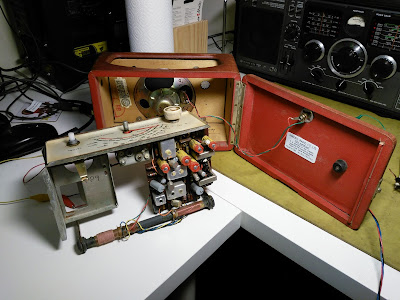- Antenna
- Q106 RF amplifier
- Pre-selectors L113 to L117 for SW1 to SW5 bands respectively.
- Q107 & T103 mix to 10.7 MHz. Local oscillator is Q108.
- Q109 10.7 MHz IF amplifier.
- 10.7 MHz ceramic filters CF101 & CF102.
- Q110 & T304 mix to 455 kHz. Local oscillator is Q111 & L120, adjustable by bandspread (VC4).
- Q302 & Q303 455 kHz IF gain.
- CF302 & CF303 if "narrow" selected.
- Q305 & T305 455 kHz IF gain.
- D307 drives the AGC & D308 detects the audio.
Issues Found
- Dirty switches. A squirt of contact cleaner and some exercise solved this issue.
- FM band was dead. This turned out to be Q103 (2SC930D), the local oscillator transistor. This had insufficient gain and was replaced with a SS9018G. Realignment of the oscillator was then required.
- I also replaced Q108, another 2SC930D functioning as the short wave local oscillator. This required realignment of all five bands.
- The ceramic filters seem to have drifted over time. This requires that the IF is aligned to this new frequency. I should have realised this before aligning the oscillators as I had to do that again!
- The bandwidth of the FM IF is too narrow for good reception. This is due to the ceramic resonators used. The radio shares some IF stages in different bands, so compromises are inevitable.
- The "SW5" band (20 to 30 MHz) is very sensitive to the position of the band select switch. Switch cleaner did not improve this, and I am reluctant to try to dismantle the switch for fear of doing more harm than good.
Low Gain 2SC930D Transistors
Q302 2sc930e gain measured at 34.
Q305 2sc930d gain measured at 33.
Ceramic Filter Drift
Using An Even Older Signal Generator!
Conclusion
- The signal strength meter reads very low on the FM band. I think this has been an issue from new, as the corresponding preset was set at the maximum setting.
- The "Band Spread" dial calibration is poor. It is fine around zero, but is progressively inaccurate as the frequency is increased. Generally, the band spread feature doesn't seem that useful anyway. Attempting to correct this with the relevant oscillator tuned circuit results in running out of capacitance adjustment range.
- Something is wrong with the BFO circuit as attempting to align this according to the manual reveals a tuned circuit with no effect. However, SSB signals can be heard well enough so I didn't pursue it.
- I have no good way of measuring the sensitivity, but suspect that it isn't as good as suggested in the manual. It would be interesting to try it with a calibrated source of some sort.




















